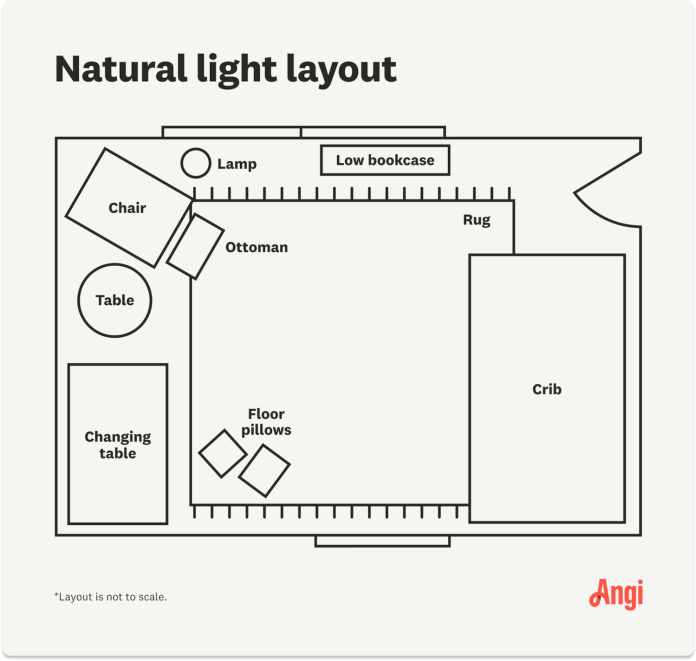Planning for a nursery can be an exciting and joyful experience, but it can also come with its fair share of challenges. One of the crucial decisions to make is choosing the right crib size based on the dimensions of your nursery. After all, you want to create a cozy and safe space for your little one to sleep and grow. In this article, we will explore the various crib sizes available and provide you with helpful tips on how to select the perfect crib that fits seamlessly into your nursery’s dimensions. With our guidance, you’ll be well-equipped to make an informed decision and create a comfortable haven for your baby. Choosing the right crib size for your nursery is an essential decision to make as new parents. It not only affects the overall aesthetics of the room but also ensures the safety and comfort of your little one. There are several factors to consider when choosing the crib size, and in this article, we will explore each one to help you make an informed decision. So let’s dive in!
Review contents
Measure the Nursery Space
Before you start looking for crib sizes, it’s crucial to measure the nursery. Taking accurate measurements will give you a clear idea of the available space and help you determine the maximum crib size that can comfortably fit. Remember to measure the length, width, and height of the area where you plan to place the crib.
Take into Account Other Furniture
While considering crib sizes, it’s important to think about the other furniture pieces in the nursery. If you have a dresser, changing table, or rocking chair, their dimensions should be taken into account. You don’t want the crib to overcrowd the room or make it difficult to access other furniture.
Consider Future Use
Choosing the right crib size also involves thinking about its future use. Will you be using the crib for multiple children? If so, opting for a larger size that can accommodate growing children might be a wise choice. Alternatively, if you plan to transition your child into a toddler bed soon, a smaller crib size can be sufficient.
Think about Accessibility
Accessibility is another vital consideration when selecting a crib size. Ensure that there is enough space around the crib for you to comfortably reach in and tend to your baby’s needs. Additionally, think about how the crib will fit through doorways and hallways during installation or when moving it to a different room.
Consider Potential Safety Hazards
Safety should always be a top priority when choosing a crib size. Consider any potential safety hazards that may arise due to the different crib sizes. For example, if you opt for a larger crib, make sure there are no gaps between the crib and the wall that could pose a risk. Similarly, for smaller crib sizes, ensure that the baby has enough room to move and breathe comfortably.
Now that we’ve discussed the considerations to keep in mind let’s explore the common crib sizes available in the market.
Common Crib Sizes
Standard Crib Size
The standard crib size is the most commonly available size and typically measures around 52″ in length and 28″ in width. These cribs are designed to fit a standard crib mattress, making it easier to find bedding and accessories. Standard cribs are suitable for most nursery sizes and offer a wide variety of designs and styles.
Mini Crib Size
Mini cribs are a great option for smaller nurseries or if you prefer a more compact crib. They are generally around 38″ in length and 24″ in width, making them significantly smaller than standard cribs. However, it’s important to note that mini cribs often come with a thinner mattress and may not accommodate your child for an extended period.
Portable Crib Size
Portable cribs, also known as travel cribs, are designed for easy transportation and storage. They are typically smaller than standard cribs and can be folded or disassembled when not in use. Portable cribs are an excellent choice for families who frequently travel or have limited space in their home.
Convertible Crib Size
Convertible cribs are a popular choice among modern parents for their versatility. These cribs can be converted into different bed types, such as toddler beds, daybeds, or even full-sized beds. Convertible cribs come in various sizes, depending on the specific model and conversion options.
Now that we have explored the common crib sizes, let’s dive deeper into each one to understand their dimensions, advantages, and considerations.
Standard Crib Size
Dimensions
Standard cribs typically measure around 52″ in length and 28″ in width. The mattress size for a standard crib is usually 52″ x 28″. These dimensions offer ample space for the baby to sleep comfortably and provide room for growth.
Advantages
One of the significant advantages of standard cribs is the wide variety of designs and styles available. You can choose from different finishes, materials, and features to match your nursery decor. Additionally, standard crib-sized mattresses and bedding accessories are easily accessible in stores, offering you more options and convenience.
Considerations
While standard cribs are versatile and widely available, they might not be suitable for smaller nurseries or homes with limited space. It’s important to measure the nursery and ensure that the crib can fit comfortably without making the room feel cramped. Additionally, if you plan to have multiple children, you may need to consider the durability and longevity of the crib.
Mini Crib Size
Dimensions
Mini cribs are significantly smaller than standard cribs, measuring around 38″ in length and 24″ in width. The mattress size for a mini crib is typically 38″ x 24″. These cribs are designed to save space and are ideal for smaller nurseries or if you prefer a more compact option.
Advantages
One of the main advantages of mini cribs is their space-saving design. They can comfortably fit into smaller rooms without compromising on the baby’s comfort. Mini cribs are also a great choice for apartments or homes with limited nursery space. Despite their smaller size, they still provide a cozy and secure sleeping environment for your baby.
Considerations
While mini cribs offer space-saving benefits, it’s important to consider the future use of the crib. These cribs may not accommodate your child for an extended period and may require transitioning to a toddler bed sooner than larger crib sizes. Additionally, finding bedding and accessories specifically designed for mini cribs might be more challenging compared to standard crib sizes.
Portable Crib Size
Dimensions
Portable cribs come in various sizes, but they are generally smaller than standard cribs. The dimensions can vary from model to model, with lengths ranging from 36″ to 45″ and widths ranging from 20″ to 30″. The mattress size for a portable crib can range from 36″ x 20″ to 45″ x 30.
Advantages
The main advantage of portable cribs is their lightweight and compact design, making them easy to transport and store. They are perfect for families who frequently travel or need a crib that can be easily moved from room to room. Portable cribs are also a great option for grandparents’ homes or daycare facilities.
Considerations
While portable cribs offer convenience and mobility, their smaller size may not provide as much room for the baby to move around or stretch out. It’s important to consider the age and size of your child when opting for a portable crib to ensure they have a comfortable sleeping space. Additionally, the thinner mattresses used in portable cribs may not offer the same level of support and comfort as standard crib mattresses.
Convertible Crib Size
Dimensions
Convertible cribs come in various sizes, depending on the model and conversion options. The dimensions can vary, but they often resemble standard crib sizes, ranging around 52″ in length and 28″ in width. The mattress size for convertible cribs usually matches the standard crib mattress size of 52″ x 28″.
Advantages
The key advantage of convertible cribs is their ability to adapt and grow with your child. These cribs can be converted into different bed types, such as toddler beds or full-sized beds, providing long-term value. Convertible cribs allow you to make a one-time investment in a quality piece of furniture that can serve your child from infancy through their teenage years.
Considerations
In terms of considerations, convertible cribs often come at a higher price point compared to other crib sizes. You should also take into account the space required for the different conversions. For example, if you plan to convert the crib into a full-sized bed, ensure that there is enough space in the room to accommodate the larger bed.
Now that we have explored the different crib sizes and their respective advantages and considerations, let’s delve into the factors to consider when choosing the right crib size.
Factors to Consider when Choosing the Right Crib Size
Nursery Size
Considering the available space in the nursery is crucial when choosing the right crib size. Measure the room dimensions and ensure that the crib can comfortably fit without making the space feel cramped. A good rule of thumb is to leave enough room for other furniture pieces and for easy access to the crib from different angles.
Other Furniture
Take into account the existing furniture in the nursery when selecting a crib size. Ensure that there is enough space for all the essential pieces, such as a dresser, changing table, or rocking chair. If the nursery is already furnished, opt for a crib size that complements the overall layout and does not overcrowd the room.
Future Use
Think about your long-term plans for the crib when making a decision. If you plan to have multiple children, consider a larger crib size that can accommodate growing children. On the other hand, if you anticipate transitioning your child into a toddler bed soon, a smaller crib size can be sufficient.
Accessibility
Accessibility is an important factor to consider for both your convenience and the baby’s safety. Ensure that there is enough space around the crib for you to comfortably reach in and tend to the baby’s needs. Additionally, consider how the crib will fit through doorways and hallways during installation or when moving it to a different room.
Safety Concerns
Safety should be a top priority when selecting a crib size. Avoid potential hazards by choosing a crib size that meets safety standards and guidelines. Ensure there are no gaps between the crib and the wall that could pose a risk to the baby. Also, consider appropriate spacing between crib slats to prevent the baby from getting stuck or injured.
Choosing a Crib Based on Nursery Size
Measuring the nursery
Start by measuring the length, width, and height of the nursery. This will give you accurate dimensions to work with when selecting a crib size. Take note of any architectural features or obstacles that could affect the placement of the crib.
Proper crib to nursery ratio
To maintain a balanced and functional nursery, it’s important to consider the overall crib to nursery ratio. The crib should not overpower the room or make it feel crowded. Aim for a layout that allows easy movement and access to other essential furniture pieces.
Choosing a Crib Based on Other Furniture
Consider existing furniture size
Evaluate the dimensions of other furniture in the nursery and consider how they will interact with the crib. Make sure there is enough space for each piece to coexist harmoniously without compromising functionality.
Placement of other furniture
Think about the placement of other furniture relative to the crib. Ensure that there is enough distance between the crib and other pieces to allow for safe and convenient usage. Consider how easy it will be to reach the crib from different angles or sides of the room.
Allowance for movement and space
Leave enough room for movement and space in the nursery. Avoid cramming the room with too many furniture pieces, as it may hinder your ability to navigate and tend to your baby’s needs.
Safety Concerns in Choosing Crib Size
Avoiding potential hazards
Choose a crib size that minimizes potential safety hazards. Ensure there are no gaps between the crib and the wall that could trap the baby or their limbs. Additionally, opt for cribs with slats that are appropriately spaced to prevent the baby from getting stuck.
Considering safety standards
When selecting a crib, make sure it meets safety standards such as those set by the Consumer Product Safety Commission (CPSC) in the United States. Look for certifications or labels that indicate compliance with safety regulations.
Choosing appropriate spacing
Pay attention to the spacing between crib slats. The distance should be small enough to prevent the baby’s head from getting stuck but large enough to provide proper ventilation. Additionally, ensure that the crib mattress fits snugly within the crib frame to reduce the risk of entrapment.
By considering the nursery size, other furniture, future use, accessibility, and safety concerns, you can confidently choose the right crib size for your little one. Remember to prioritize safety and comfort while also keeping in mind the room’s aesthetics. Happy crib hunting!






























